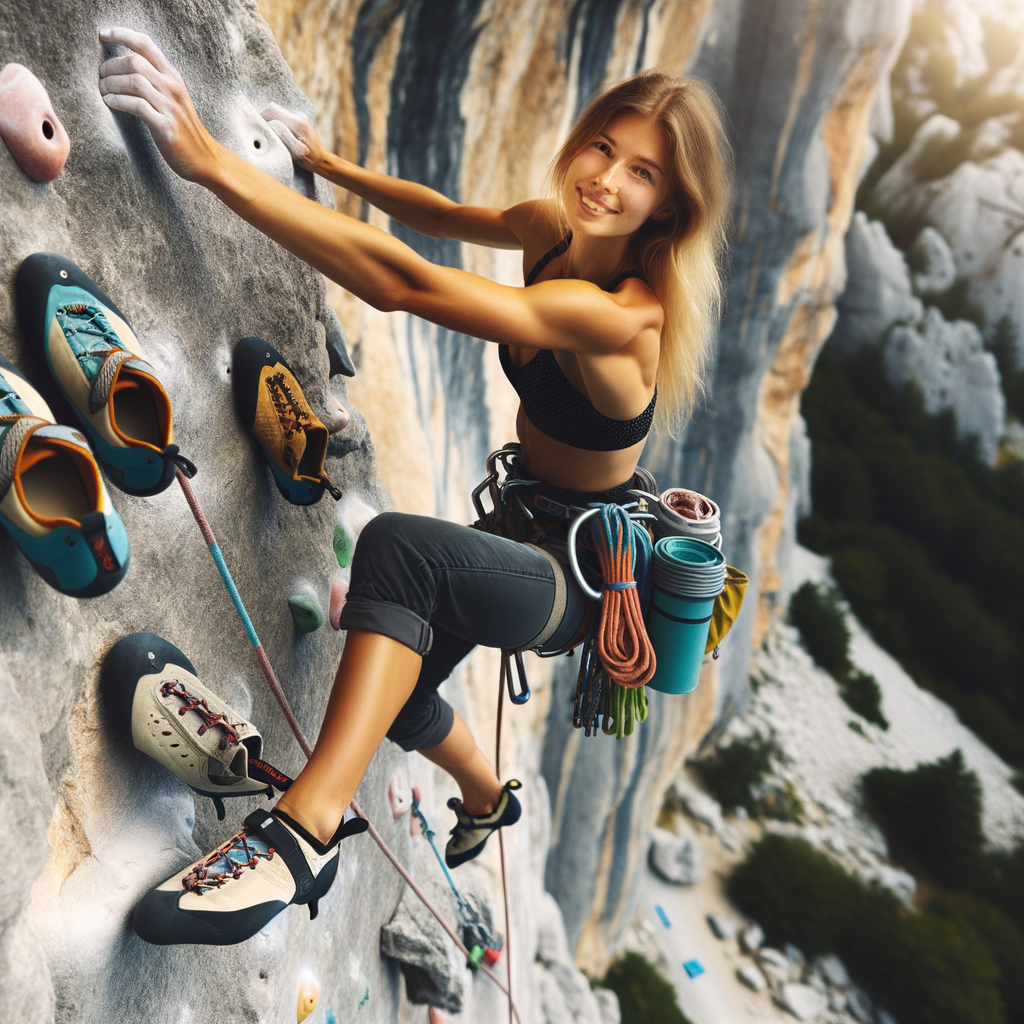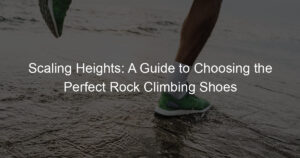
Introduction to Rock Climbing Safety
Rock climbing is an exhilarating sport that tests your physical strength, mental focus, and adventurous spirit. However, it also presents certain risks that must be managed with proper safety measures. This article aims to shed light on the importance of safety in rock climbing, common hazards encountered, and the role of equipment in ensuring a safe climbing experience.
- Importance of Safety in Rock Climbing
Rock climbing is not just about strength and agility, it’s also about safety. Ensuring safety while climbing is paramount, as it not only prevents injuries but also enhances the overall climbing experience. According to a study, approximately 3.5 million people in the United States participate in rock climbing each year, and about 40,000 of them receive emergency room treatment for climbing-related injuries. Therefore, understanding and implementing safety measures can significantly reduce these numbers.
- Common Hazards in Rock Climbing
Rock climbing, like any other sport, comes with its own set of hazards. Some of the common risks include falling, rockfall, equipment failure, and adverse weather conditions. Falling is the most common cause of injuries, often due to a loss of grip or footing. Rockfall, or loose rocks falling from above, can also pose a significant risk. Equipment failure, although less common, can result in severe injuries. Lastly, adverse weather conditions such as rain, wind, or lightning can make climbing dangerous.
- Role of Equipment in Ensuring Rock Climbing Safety
Proper equipment plays a crucial role in ensuring safety during rock climbing. This includes helmets to protect from rockfall and falling, harnesses for secure attachment to the climbing rope, carabiners to connect different parts of the climbing system, and belay devices to control a rope during belaying. Climbing shoes also play a vital role in providing the necessary grip on the rock surface. It’s important to remember that all equipment should be checked regularly for any signs of wear and tear.
In conclusion, safety should be the top priority in rock climbing. By understanding the risks, taking necessary precautions, and using the right equipment, you can enjoy this thrilling sport while minimizing potential dangers.
The Role of Climbing Footwear in Rock Climbing Safety
When it comes to rock climbing safety, the importance of appropriate footwear cannot be overstated. Let’s delve into the role of climbing footwear in ensuring a safe and successful climb.
Understanding the Importance of Climbing Footwear
Climbing shoes are not just another piece of gear. They serve a critical role in enhancing your climbing performance and safety. Here are some key points to understand:
- How climbing shoes enhance grip: The rubber soles of climbing shoes are designed to provide superior grip on rock surfaces. This is crucial in maintaining balance and preventing slips or falls. For instance, a study by the American Alpine Club found that 47% of climbing accidents were caused by slips or falls, highlighting the importance of a good grip.
- Importance of fit in climbing shoes: A well-fitted climbing shoe is essential for comfort and performance. Shoes that are too tight can cause discomfort and potential injuries, while those that are too loose can compromise your grip and balance. According to a survey by the British Mountaineering Council, 75% of climbers reported better performance with properly fitted shoes.
- How climbing shoes protect against foot injuries: Climbing shoes are designed to protect your feet from sharp rocks and rough surfaces. They also provide support to your feet, reducing the risk of sprains or fractures. A study in the Journal of Sports Medicine found that climbers wearing appropriate footwear had a 50% lower risk of foot injuries.
In conclusion, climbing shoes play a vital role in enhancing grip, ensuring a proper fit, and protecting against foot injuries. Therefore, investing in the right footwear is a key step towards safe and enjoyable rock climbing.
Climbing Shoe Types and Their Safety Features
Understanding the different types of climbing shoes and their safety features is crucial for every climber. Let’s delve into the three main types:
- Neutral Climbing Shoes
- Moderate Climbing Shoes
- Aggressive Climbing Shoes
Neutral climbing shoes are ideal for beginners. They have a flat profile that provides comfort for long climbs and are designed to allow your toes to lay flat within the shoe. This design provides a good grip on small edges and cracks. The thick rubber sole offers excellent protection against sharp rocks and provides durability. However, they might not be the best choice for overhanging routes due to their lack of downturn.
Moderate climbing shoes are a step up from neutral shoes. They have a slightly downturned shape, which makes them suitable for more technical climbing. They offer a balance between comfort and performance. The thinner soles provide better sensitivity, allowing climbers to feel the rock beneath their feet, which can enhance their grip. The rubber on the heel and toe areas also helps in hooking and edging.
Aggressive climbing shoes are designed for challenging climbs. They have a significantly downturned shape and asymmetrical design, which helps in performing on steep overhangs and tiny holds. These shoes prioritize performance over comfort and may take some time to get used to. The thin and sticky soles provide excellent grip but may wear out faster than those of neutral or moderate shoes.
Choosing the right type of climbing shoe can significantly impact your safety and performance. Remember, the best shoe for you depends on your climbing style and the type of terrain you’ll be tackling.
| Type of Shoe | Safety Feature | Best For |
|---|---|---|
| Neutral | Thick rubber sole, good grip on small edges | Beginners, long climbs |
| Moderate | Thin soles for better sensitivity, rubber on heel and toe areas | Technical climbing |
| Aggressive | Thin and sticky soles for excellent grip | Challenging climbs, steep overhangs |
Confidence in Climbing: The Psychological Impact of Proper Footwear
When it comes to rock climbing, having the right gear is not just about physical safety. It also plays a significant role in a climber’s mental state. One of the most critical pieces of equipment is the footwear. In this section, we will explore how proper footwear can boost a climber’s confidence and the connection between confidence and safety in rock climbing.
- How the right footwear can boost confidence
Footwear designed specifically for rock climbing provides the necessary grip and stability needed to navigate the rocky terrain. When a climber knows they can trust their shoes to hold firm, they can focus more on their climbing technique and less on the fear of slipping. This trust in their gear can significantly boost their confidence.
According to a study conducted by the University of British Columbia, climbers who wore proper climbing shoes reported feeling more confident and less anxious during their climb. This increased confidence allowed them to perform better and enjoy the experience more.
- The connection between confidence and safety in rock climbing
Confidence in rock climbing is not just about feeling good. It has a direct impact on the safety of the climber. A confident climber is more likely to make calculated decisions, stick to their planned route, and react more effectively to unexpected challenges. This mindset reduces the risk of accidents and injuries.
On the other hand, a lack of confidence can lead to hesitation, rushed decisions, and potentially dangerous mistakes. Therefore, anything that can boost a climber’s confidence, like wearing the right footwear, can also enhance their safety.
In conclusion, the psychological impact of proper footwear in rock climbing is significant. It can boost confidence, which in turn can improve safety. So, next time you prepare for a climb, make sure you have the right shoes on your feet. Not only will they provide physical support, but they will also give you the mental boost you need to conquer the climb.
Safe Climbing Practices Beyond Footwear
While the right footwear is an essential part of rock climbing safety, there are other important elements to consider. In this section, we’ll explore additional rock climbing equipment that can help ensure your safety.
Additional Rock Climbing Equipment for Safety
When it comes to rock climbing, safety is paramount. Apart from the right footwear, there are other pieces of equipment that are crucial for a safe climbing experience. Let’s take a look at some of these:
- Helmets
- Harnesses
- Belay Devices
A helmet is a non-negotiable piece of safety equipment for rock climbing. It protects your head from falling debris and in case of a fall. According to a study by the American Journal of Industrial Medicine, wearing a helmet can reduce the risk of head injury by 50%.
A climbing harness is another essential piece of equipment. It secures you to the climbing rope, ensuring you won’t fall far if you lose your grip. Harnesses are designed to distribute the force of a fall across your body, reducing the risk of injury.
Belay devices are used to control a rope during belaying. They create friction that allows the belayer to easily hold the rope, even if the climber falls. This device is crucial for climbing safety, as it allows for controlled ascents and descents.
In conclusion, while footwear plays a significant role in climbing safety, it’s just one piece of the puzzle. Helmets, harnesses, and belay devices are also vital for a safe and successful climb. Remember, safety should always be your top priority when rock climbing.
Safe Climbing Techniques
When it comes to rock climbing, safety should always be your top priority. Beyond the right footwear and equipment, there are several climbing techniques that can help ensure your safety. Let’s explore some of these techniques.
-
Proper Handhold and Foothold Techniques
Knowing how to properly place your hands and feet is crucial in rock climbing. This is not only to help you ascend but also to prevent injuries. It’s important to distribute your weight evenly and avoid over-gripping, which can lead to fatigue. Remember, climbing is more about your legs than your arms. Use your feet to push yourself up and your hands for balance.
-
Safe Falling Practices
Falling is a part of climbing. However, there’s a safe way to do it. When falling, it’s important to stay relaxed and avoid trying to grab the wall, which can lead to injuries. Always trust your belayer and your equipment. Practice falling in a controlled environment before venturing out on real climbs.
-
Importance of Regular Rest and Hydration
Rock climbing is a physically demanding activity. Regular rest breaks and staying hydrated can help maintain your energy levels and prevent fatigue. Remember to drink water before, during, and after your climb. Also, listen to your body. If you feel tired or if your muscles start to shake, it’s time to take a break.
In conclusion, safe climbing techniques go beyond just having the right equipment. They involve understanding how to use your body effectively and safely. By practicing these techniques, you can enjoy the thrill of rock climbing while minimizing the risk of injuries.
Choosing the Right Footwear for Rock Climbing
When it comes to rock climbing, choosing the right footwear is crucial. The shoes you wear can significantly impact your performance, safety, and overall climbing experience. Let’s delve into the factors you should consider when buying climbing shoes.
Factors to Consider When Buying Climbing Shoes
There are several factors to consider when purchasing climbing shoes. Here are the top three:
- Fit and Comfort
- Type of Climbing
- Material and Durability
Comfort is key in climbing shoes. Your shoes should fit snugly, but not so tight that they cause pain. Remember, you’ll be wearing these shoes for extended periods, so they need to be comfortable. Try on several pairs before making a decision. Your toes should touch the end of the shoe, but they shouldn’t be squashed.
The type of climbing you plan to do also influences the kind of shoes you should buy. For instance, if you’re into bouldering or sport climbing, you might want a more aggressive shoe. On the other hand, if you’re into traditional climbing or multi-pitch routes, a more comfortable, less aggressive shoe might be the better choice.
The material of the shoe is another important factor. Leather shoes tend to stretch more than synthetic ones, so keep that in mind when choosing your size. Durability is also crucial. Look for shoes with sturdy construction and high-quality materials. They might cost more upfront, but they’ll likely last longer, saving you money in the long run.
By considering these factors, you can ensure that you choose the right footwear for your rock climbing adventures. Remember, the right shoes can make all the difference in your performance and safety.
Recommended Climbing Shoe Brands
When it comes to rock climbing, the right footwear can make a significant difference. Here are three top-notch climbing shoe brands that are highly recommended by experienced climbers:
- La Sportiva
- Scarpa
- Five Ten
La Sportiva is an Italian brand that has been in the business for over 90 years. They offer a wide range of climbing shoes, designed with innovative technology for maximum grip and comfort. Whether you’re a beginner or a seasoned climber, La Sportiva has a shoe for you. Their shoes are known for their durability, ensuring that they can withstand the rough and tough conditions of rock climbing.
Scarpa, another Italian brand, has been making climbing shoes since the 1930s. They are known for their high-quality materials and craftsmanship. Scarpa climbing shoes are designed to provide excellent performance, comfort, and fit. They offer a variety of models to suit different climbing styles and levels of expertise.
Five Ten is a U.S. brand that is popular among rock climbers for their innovative designs. Their climbing shoes are famous for their “Stealth Rubber” soles, which offer excellent grip on various surfaces. Five Ten shoes are not only functional but also stylish, making them a favorite among young climbers.
Remember, the best climbing shoe is the one that fits you well and suits your climbing style. Always try on different brands and models to find the one that feels the most comfortable and gives you the most confidence while climbing.
Conclusion: Step Up Your Climbing Game Safely
As we reach the end of our journey through the world of rock climbing safety, let’s take a moment to reflect on the key points we’ve covered. It’s crucial to remember that safety should always be your top priority when embarking on any climbing adventure.
- Recap of the importance of proper footwear in rock climbing safety:
- Final thoughts on safe climbing practices:
Throughout our discussion, we’ve emphasized the vital role that proper footwear plays in ensuring your safety while rock climbing. A good pair of climbing shoes provides the necessary grip and support, helping you maintain balance and prevent slips and falls. Remember, the right footwear is not just about comfort; it’s a critical component of your safety gear.
Beyond footwear, we’ve explored other essential safe climbing practices. These include using the correct climbing gear, understanding and respecting your limits, and always climbing with a partner. It’s also important to learn and practice climbing techniques before attempting more challenging climbs.
Rock climbing is a thrilling sport that tests your physical strength and mental resilience. However, it’s essential to approach it with the right mindset and preparation. By choosing the correct footwear and adhering to safe climbing practices, you can enjoy the sport while minimizing the risk of injury.
Remember, the mountain will always be there, but you won’t be if you don’t prioritize your safety. So, step up your climbing game safely and enjoy the exhilarating journey to the top!











